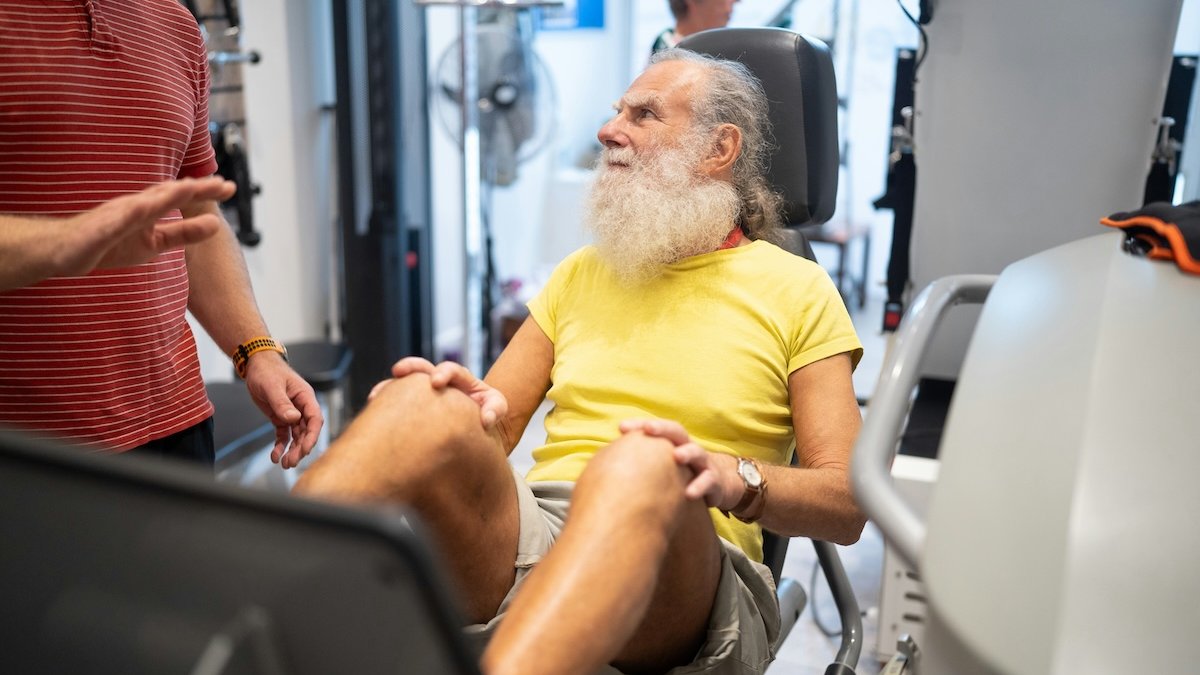
Sleep problems become more common with age. In fact, about 30–48% of older adults report daytime sleepiness and 12–20% meet criteria for insomnia. Poor sleep in seniors is linked to many health issues – depression, anxiety, metabolic syndrome, hypertension and heart disease are all associated with insomnia. Treating sleep problems without drugs is especially important for older people, since sleep medications can have long-lasting side effects. Not surprisingly, experts recommend non-pharmacological approaches first. One simple, low-cost strategy is exercise – “exercise is … beneficial for alleviating insomnia in older adults”. In short, staying active can help seniors sleep better by promoting hormonal balance, reducing stress, and building physical strength.
Strength Training and Sleep
Strength (resistance) training uses weights or resistance (dumbbells, bands, bodyweight) to build muscle. A recent review found that strength exercises gave the biggest boost to sleep quality in older insomniacs. In a meta-analysis of 25 trials, strength training lowered the global sleep disturbance score (PSQI) much more than other exercise types. In fact, strength training showed the largest improvement (unstandardized mean difference –5.75) with a 94.6% probability of being the best strategy. In practical terms, older adults doing regular resistance workouts (for example, weight machines or bodyweight squats/push-ups) reported much deeper, more restorative sleep. Similarly, a clinical trial comparing seniors doing weights vs. aerobic activity found both helped sleep quality, but the strength-training group saw greater gains in sleep duration and efficiency than the aerobic group pmc.ncbi.nlm.nih.gov.
There are good physiological reasons why strength work helps sleep. Resistance exercise causes muscles to use energy and then recover, which can make the body feel tired in a healthy way. It also boosts sleep-related hormones: studies show regular exercise increases nighttime melatonin (the “sleep hormone”), helping people fall asleep faster nature.com. Exercise raises body temperature, and the post-workout cooldown then triggers drowsiness – the drop in core temperature after exercise promotes sleep onset nature.com. Strength training also reduces stress and improves mood, which in turn makes it easier to relax at night nature.com. For older adults, building muscle has extra benefits: it fights age-related muscle loss (sarcopenia) and helps prevent falls. As one sports medicine expert noted, “combatting sarcopenia and ... preventing falls” is critical for seniors, underscoring why resistance training is so important beyond just sleep medicalnewstoday.com.
Cardio/Aerobic Training and Sleep
Cardio (aerobic) exercise includes activities like brisk walking, cycling, swimming or water aerobics. These raise the heart rate and improve circulation. Research shows aerobic workouts also improve sleep quality in older adults. For example, a subgroup analysis found that older adults doing aerobic exercise alone saw their Pittsburgh Sleep Quality Index scores drop significantly (USMD –4.36) compared to doing no exercise. In other words, regular moderate cardio led to several more hours of restful sleep per night. Other studies confirm that even a moderate program (e.g. 30 minutes of brisk walking, 3 times a week for 8 weeks) can meaningfully improve insomnia symptoms nature.com.
Like strength training, aerobic exercise works through multiple biological pathways to aid sleep. It raises melatonin levels and helps regulate the body’s circadian clock nature.com. It also reduces anxiety and depression – both common in people with insomnia – by releasing endorphins and improving mood nature.com. After a workout, a gentle decline in body temperature promotes sleepiness nature.com. Cardio can also make the body physically tired in a healthy way: for example, uphill walking or swimming engages large muscles and burns energy, so the body naturally craves rest later. Overall, both long-term studies and short-term trials find that moderate-intensity aerobic exercise (like daily walking or water aerobics) helps seniors fall asleep faster and sleep more soundly.
Strength vs. Cardio: Which is Best for Sleep?
Most evidence suggests strength (resistance) workouts have the edge. In head-to-head comparisons, weight training consistently produced larger sleep gains than cardio or combined programs pmc.ncbi.nlm.nih.gov. In one analysis pooling many trials, strength exercises ranked highest (94.6% probability of being best), while aerobic exercise and mixed routines also helped but to a lesser degree. For example, combined exercise (yoga/Pilates mix) improved sleep scores by about –2.35, and aerobic by –3.76, versus –5.75 for strength training. In practical terms, a senior adding 2–3 sessions of weight-bearing or resistance-band workouts per week saw more improvement than if they only walked or did yoga.
However, aerobic exercise is still very beneficial. Studies show any movement is better than none – people in the cardio group also got significantly better sleep pmc.ncbi.nlm.nih.gov. One trial found both resistance and aerobic training improved sleep quality in older adults, even though resistance had a slight edge in metrics like sleep efficiency pmc.ncbi.nlm.nih.gov. In other words, brisk walking or cycling can help an older person who has trouble sleeping, just as lifting weights can. Moreover, experts emphasize variety: combining aerobic, strength, and balance exercises yields the most health benefits cdc.govmedicalnewstoday.com.
It’s also notable that moderate intensity seems to work best. The same meta-analysis found that low- to moderate-intensity workouts actually produced larger sleep improvements than very hard sessions. Very vigorous exercise, especially if done right before bedtime, can sometimes delay melatonin and make falling asleep harder nature.com. In contrast, gentle to moderate workouts earlier in the day – a steady-paced jog or water aerobics class – help body temperature and stress levels normalize by bedtime, promoting sleep.
Practical Exercise Tips for Better Sleep
- Aim for both cardio and strength workouts each week. Guidelines for older adults recommend about 150 minutes of moderate aerobic activity per week (for example 30 minutes a day, 5 days a week) plus at least 2 days of muscle-strengthening exercises (working all major muscle groups) cdc.gov. Following this mix (walking, swimming or biking together with light weight/resistance training) will support overall health and sleep.
- Keep it moderate and consistent. Moderate-intensity exercise (enough to raise your heart rate but still allow talking) is key. Research shows moderate workouts reduce insomnia most, possibly because very hard late-day exercise can interfere with sleep nature.com. Spread activity throughout the week rather than one marathon session: e.g. 30 minutes of brisk walking or water aerobics on most days, and 2–3 short strength sessions (using bands or light weights) on other days.
- Time it right. Avoid very vigorous exercise in the hour before bedtime. Gentle evening stretching is fine, but a hard workout too late can delay melatonin release nature.com. Morning or afternoon sessions often work best for encouraging sleep that night.
- Choose activities you enjoy. Walking, water aerobics, cycling, gardening or dancing all count as cardio. Chair exercises, light weightlifting, yoga and tai chi can build strength gently. The goal is regular movement. Even short 10-minute walking or weight routines can add up. If mobility or pain is an issue, water exercises or chair-based strength moves are excellent low-impact options.
- Be patient and gradual. If you’re new to exercise, start slowly (e.g. 10 minutes at a time) and build up. Over weeks, most older adults feel less fatigue and begin to notice deeper sleep. And as one expert notes, exercise helps address “sarcopenia” and fall risk, which not only improves sleep but supports healthy aging medicalnewstoday.com.
- Combine exercise with sleep hygiene. While exercise helps, be sure to also follow good sleep habits (consistent bedtime, cool dark room, limited caffeine/alcohol). Exercise is one powerful tool in a broader plan (alongside counseling or sleep therapy if needed) to beat insomnia.
Regular exercise is a safe, drug-free way to improve sleep and health in older age. The evidence suggests strength training (resistance exercises) may give the biggest payoff for sleep quality, though cardio exercise also provides significant benefits pmc.ncbi.nlm.nih.gov. In practice, a balanced program of both, tailored to an individual’s abilities, will offer the best chance of waking up refreshed.
Research shows exercise (especially strength training) significantly improves sleep quality in older adults pmc.ncbi.nlm.nih.gov. Clinical guidelines recommend a mix of 150 minutes/week of moderate aerobic activity plus 2 days of strength training for seniors cdc.gov. (Additional context from public health and expert sources is described in the text.)
Sources
https://pmc.ncbi.nlm.nih.gov/articles/PMC9210554/
https://www.nature.com/articles/s44323-024-00018-w
Is strength training the best exercise to beat insomnia?
Older Adult Activity: An Overview | Physical Activity Basics | CDC
https://www.cdc.gov/physical-activity-basics/guidelines/older-adults.html
Michael Thompson
Editorial team member at Sleep Now

